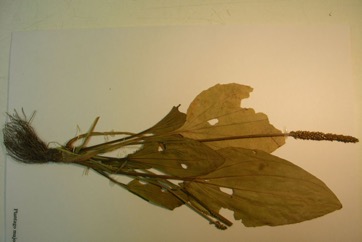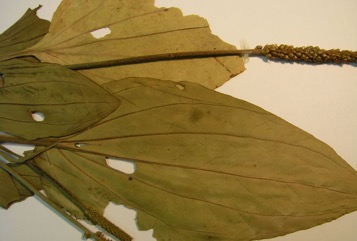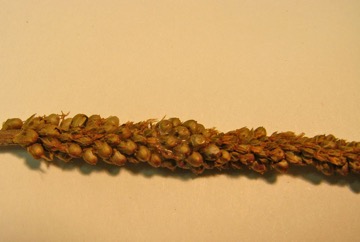Common plantain, Broadleaf plantain, Greater plantain

It is a temperate plant. It grows in damp places. It grows in wetlands. It grows mostly in cool places. In Argentina it grows below 500 m above sea level. Tasmania Herbarium. In Yunnan. In Sichuan.
Also known as:
Ah-gwaw-paung-ta-htaung, Akyaw-baung-tha-thaung, Babka, Baga, Bag yapragi, Balazagva, Belgheviz, Bolila ba lipoli, Broad-leafed plantain, Bud-gull, Che qian, Cheuli, Damarliot, Damar otu, Daun sejumbok, Daun sendok, Ekur anjing, Ghuzbe, Gul, Isabgol, Isafghol, Karet, Kel-ba-an, Kesikotu, Ki arut, Kirksinirotu, Kolocier, Kolosija, Kopakopa, Lengue pechere, Lessan-imthaur, Llanten, Llanten mayor, Luhuriya, Ma de, Mravaldzargva, Nido marto, Ominwas, Orecchie d'asino, Padaroznik, Pel hewes, Pelonbas, Plantatge ample, Plantain, Planten, Pulung nyang, Rat's-tail plantain, Sangka-buwah, Sangkubah, Se-gyaw-paung-ta-htaung, Se-kyaw-gyi, Sepodi, Sinirliot, Sinirotu, Teeleht, Tharam, Tirafilo, Torraja cimarrona, Torreja cimarrona, Veliki trpotec, Yara otu, Yempat, Zenska bokvica
Synonyms
- Plantago asiatica L.
- Plantago depressa Willd.
- Plantago loureiri Roem. et Schult.
- Plantago crenata Blanco
- Plantago erosa Wall.
- Plantago media Blanco
Edible Portion
- Leaves, Seeds, Leaves - tea, Roots, Vegetable
Where does Common plantain grow?
Found in: Africa, Alaska, American Samoa, Angola, Argentina, Armenia, Asia, Australia, Austria, Balkans, Belarus, Bosnia, Brazil, Britain, British Indian Ocean Terr., BIOT, Canada, Caucasus, Central America, Central Asia, Chile, China, Croatia, Cuba, Denmark, Dominican Republic, East Africa, Easter Island, East Timor, Ecuador, Estonia, Eswatini, Europe, Falklands, France, Georgia, Greece, Guatemala, Guiana, Guianas, Guyana, Haiti, Himalayas, Hungary, India, Indochina, Indonesia, Italy, Haiti, Kazakhstan, Korea, Kyrgyzstan, Laos, Lesotho, Lithuania, Luxembourg, Macedonia, Madagascar, Mediterranean, Mongolia, Myanmar, Nepal, New Zealand, Norfolk Island, North Africa, North America, Northeastern India, NW India, Norway, Pacific, Pakistan, Papua New Guinea, PNG, Peru, Puerto Rico, Russia, Sao Tome and Principe, Scandinavia, SE Asia, Slovakia, Slovenia, South Africa, Southern Africa, South America, Spain, St Helena, St Lucia, Suriname, Swaziland, Sweden, Taiwan, Tasmania, Tibet, Timor-Leste, Tonga, Turkey, Ukraine, Uruguay, United States, Uzbekistan, Venezuela, Vietnam, Virgin Islands, West Indies, Yemen, Zambia, Zimbabwe
Notes: Leaves reported to contain a small amount of Vitamin C. The plantains or Plantaginaceae are mostly in temperate regions. There are about 165 Plantago species.
Status: It is sold in markets in India.
Growing Common plantain, Broadleaf plantain, Greater plantain
Cultivation: Plants can be grown by seeds.
Edible Uses: Young leaves are lightly cooked. Older leaves become more bitter. The leaves are used in soups. The leaves can be dipped in batter and fried over low heat. They are also used in chutney. The leaves are used for sarma in Turkey. They are rolled around a filling of rice or minced meat. The dried leaves are used for tea. The seeds are used to give a jelly like effect in drinks. They can be ground into a meal. The seeds yield an edible oil. The roots are eaten cooked.
Nutrition Info
per 100g edible portion| Edible Part | Energy (kcal) | Protein (g) | Iron (mg) | Vitamin A (ug) | Vitamin c (mg) | Zinc (mg) | % Water |
|---|---|---|---|---|---|---|---|
| Leaves | 61 | 3.8 | 1.2 | 11000 IU | 19 | - | 81.4 |
| Leaves | 39 | 2.1 | - | - | - | - | 85 |
Common plantain, Broadleaf plantain, Greater plantain Photos



References
Alimenticias - FloraSBS
Al-Fatimi, M. A., Wild Edible Plants Traditionall Collected and Used in Southern Yemen. Research Square. University of Aden. p 22
Ambasta, S.P. (Ed.), 2000, The Useful Plants of India. CSIR India. p 467
Arora, R. K., 2014, Diversity in Underutilized Plant Species - An Asia-Pacific Perspective. Bioversity International. p 44
Beckstrom-Sternberg, Stephen M., and James A. Duke. "The Foodplant Database." http://probe.nalusda.gov:8300/cgi-bin/browse/foodplantdb.(ACEDB version 4.0 - data version July 1994)
Bennett, B. C., 1990, Useful Plants of Amazonian Ecuador. US Agency for International Development. Fifth Progress Report. New York Botanical Gardens. p 39
Biscotti, N. et al, 2018, The traditional food use of wild vegetables in Apulia (Italy) in the light of Italian ethnobotanical literature. Italian Botanist 5:1-24
Blamey, M and Grey-Wilson, C., 2005, Wild flowers of the Mediterranean. A & C Black London. p 421
Bodkin, F., 1991, Encyclopedia Botanica. Cornstalk publishing, p 809
Bonet, M. A. & Valles, J., 2002, Use of non-crop food vascular plants in Montseny biosphere reserve (Catalonia, Iberian Peninsula). International Journal of Food Sciences and Nutrition (2002) 53, 225–248
Bremness, L., 1994, Herbs. Collins Eyewitness Handbooks. Harper Collins. p 203
Bowser, M., 2017, Handout on Edible Plants of the Kenai Peninsula. USFWS Kenai National Wildlife Refuge p 16
Burkill, I.H., 1966, A Dictionary of the Economic Products of the Malay Peninsula. Ministry of Agriculture and Cooperatives, Kuala Lumpur, Malaysia. Vol 2 (I-Z) p 1797
Cerne, M., 1992, Wild Plants from Slovenia used as Vegetables. Acta Horticulturae 318
"Chinese Nutrition Journal", 2002, Vol 23(8) p 298
Cordero, S. E., Abello, L. A., & Galvez, F. L., 2017, Plantas silvestres comestibles y medicinales de Chile y otras partes del mundo. CORMA p 220
Cormack, R. G. H., 1967, Wild Flowers of Alberta. Commercial Printers Edmonton, Canada. p 319
Crate, S. A., 2008, "Eating Hay": The Ecology, Economy and Culture of Viliui Sakha Smallholders of Northeastern Siberia. Human Ecology 36:161-174
Crawford, M., 2012, How to grow Perennial Vegetables. Green Books. p 150
Curtis, W.M., 1993, The Student's Flora of Tasmania. Part 3 St David's Park Publishing, Tasmania, p 559
Dashorst, G.R.M., and Jessop, J.P., 1998, Plants of the Adelaide Plains & Hills. Botanic Gardens of Adelaide and State Herbarium. p 134
Denes, A., et al, 2012, Wild plants used for food by Hungarian ethnic groups living in the Carpathian Basin. Acta Societatis Botanicorum Poloniae 81 (4): 381-396
de Polle, E., Plantas Silvestres Comestible de Guatemala. 1(1) Universidad de San Carlos de Guatemala.
Dobriyal, M. J. R. & Dobriyal, R., 2014, Non Wood Forest Produce an Option for Ethnic Food and Nutritional Security in India. Int. J. of Usuf. Mngt. 15(1):17-37
Dogan, Y., et al, 2015, Of the importance of a leaf: the ethnobotany of sarma in Turkey and the Balkans. Journal of Ethnobiology and Ethnomedicine, 11:56
Dolina, K. & Luczaj, L., 2014, Wild food plants used on the Dubrovnik coast (south-eastern Croatia) Acta Soc Bot Pol 83(3):175–181
Duke, J.A., 1992, Handbook of Edible Weeds. CRC Press. p 150
Elias, T.S. & Dykeman P.A., 1990, Edible Wild Plants. A North American Field guide. Sterling, New York p 79
Ertug, F, Yenen Bitkiler. Resimli Türkiye Florası -I- Flora of Turkey - Ethnobotany supplement
Esperanca, M. J., 1988. Surviving in the wild. A glance at the wild plants and their uses. Vol. 2. p 156
Facciola, S., 1998, Cornucopia 2: a Source Book of Edible Plants. Kampong Publications, p 173
Flora of Pakistan. www.eFloras.org
Fox, F. W. & Young, M. E. N., 1982, Food from the Veld. Delta Books. p 293
Grivetti, L. E., 1980, Agricultural development: present and potential role of edible wild plants. Part 2: Sub-Saharan Africa, Report to the Department of State Agency for International Development. p 65
Guil-Guerrero, J. L., et al, 2001, Edible Wild Plants. in Recent Progress in Medicinal Plants Vol. 8 Sci. Tech publishing, Texas
Hadjichambis, A. C., et al, 2007, Wild and semi-domesticated food plant consumption in seven circum-Mediterranean areas. International Journal of Food Sciences and Nutrition. 2007, 1-32.
Hani Medicine of Xishuangbanna, 1999, p 267
Hedrick, U.P., 1919, (Ed.), Sturtevant's edible plants of the world. p 507
Henty, E.E., & Pritchard, G.S., 1973, Weeds of New Guinea and their control. Botany Bulletin No 7, Division of Botany, Lae, PNG. p 136
Hibbert, M., 2002, The Aussie Plant Finder 2002, Florilegium. p 236
http://nordicfood lab/org/blog/2102/9/wild-edible-plants-an-overview
http://www.botanic-gardens-ljubljana.com/en/plants
Hussey, B.M.J., Keighery, G.J., Cousens, R.D., Dodd, J., Lloyd, S.G., 1997, Western Weeds. A guide to the weeds of Western Australia. Plant Protection Society of Western Australia. p 196
Huxley, A. (Ed.), 1977, The Encyclopedia of the Plant Kingdom. Chartweil Books. p 227
Hu, Shiu-ying, 2005, Food Plants of China. The Chinese University Press. p 677
Hyde-Wyatt, B.H. & Morris D.I., 1975, Tasmanian Weed Handbook. Dept of Ag Tasmania. p 88
Irving, M., 2009, The Forager Handbook, A Guide to the Edible Plants of Britain. Ebury Press p 250
Jardin, C., 1970, List of Foods Used In Africa, FAO Nutrition Information Document Series No 2.p 95
Kaliszewska, I & Kolodziejska-Degorska, I, 2015, The social context of wild leafy vegetables uses in Shiri, Daghestan. Journal of Ethnobiology and Ethnomedicine, 11:63
Kalle, R. & Soukand, R., 2012, Historical ethnobotanical review of wild edible plants of Estonia (1770s-1960s) Acta Societatis Botanicorum Poloniae 81(4):271-281
Kar, A., 2004, Common wild vegetables of Aka tribe of Arunachal Pradesh. Indian Journal of Traditional Knowledge 3(3) pp 305-313
Kar, A., et al, 2013, Wild Edible Plant Resources used by the Mizos of Mizoram, India. Kathmandu University Journal of Science, Engineering and Technology. Vol. 9, No. 1, July, 2013, 106-126
Kermath, B. M., et al, 2014, Food Plants in the Americas: A survey of the domesticated, cultivated and wild plants used for Human food in North, Central and South America and the Caribbean. On line draft. p 670
Khan, M. & Hussain, S., 2014, Diversity of wild edible plants and flowering phenology of district Poonch (J & K) in the northwest Himalaya. Indian Journal of Sci, Res. 9(1): 032-038
Kizilarslan, C. & Ozhatay, N., 2012, An ethnobotanical study of the useful and edible plants of İzmit. Marmara Pharmaceutical Journal 16: 134-140, 2012.
Lamp, C & Collet F., 1989, Field Guide to Weeds in Australia. Inkata Press. p 220
Lautenschläger, T., et al, 2018, First large-scale ethnobotanical survey in the province of Uíge, northern Angola. Journal of Ethnobiology and Ethnomedicine (2018) 14:51
Lazarides, M. & Hince, B., 1993, Handbook of Economic Plants of Australia, CSIRO. p 192
Lim, T. K., 2015, Edible Medicinal and Non Medicinal Plants. Volume 9, Modified Stems, Roots, Bulbs. Springer p 66
Long, C., 2005, Swaziland's Flora - siSwati names and Uses http://www.sntc.org.sz/flora/
Low, T., 1991, Wild Herbs of Australia and New Zealand. Angus & Robertson. p 48 (Drawing)
Luczaj, L., 2012, Ethnobotanical review of wild edible plants of Slovakia. Acta Societatis Botanicorum Poloniae 81(4):245-255
Luczaj, L. et al, 2017, Comfrey and Buttercup Eaters: Wild Vegetables of the Imereti Region in Western Georgia, Caucasus. Economic Botany, 71(2), 2017, pp. 188–193
Mabey, R., 1973, Food for Free. A Guide to the edible wild plants of Britain, Collins. p 105
MacKinnon, A., et al, 2009, Edible & Medicinal Plants of Canada. Lone Pine. p 256
Malezas Comestibles del Cono Sur, INTA, 2009, Buernos Aires
Martin, F.W. & Ruberte, R.M., 1979, Edible Leaves of the Tropics. Antillian College Press, Mayaguez, Puerto Rico. p 80
Mir, M. Y., 2014, Documentation and ethnobotanical survey of wild edible plants used by the tribals of Kupwara, J & K, India. International Journal of Herbal Medicine. 2(4): 11-18
Moerman, D. F., 2010, Native American Ethnobotany. Timber Press. p 416
Morley, B.D., & Toelken, H.R., (Eds), 1983, Flowering Plants in Australia. Rigby. p 285
Ogle, B. M., et al, 2003, Food, Feed or Medicine: The Multiple Functions of Edible Wild Plants in Vietnam. Economic Botany 57(1): 103-117 (Also as Plantago asiatica)
Ozbucak, T. B. et al, 2006, The Contribution of Wild Edible Plants to Human Nutrition in the Black Sea Region of Turkey. Ethnobotanical Leaflets 10: 98-103
Paczkowska, G . & Chapman, A.R., 2000, The Western Australian Flora. A Descriptive Calatogue. Western Australian Herbarium. p 457
Paoletti, M.G., Dreon, A.L., and Lorenzoni, G.G., 1995, Pistic, Traditional Food from Western Friuli, NE Italy. Economic Botany 49(1) pp 26-30
Pieroni, A., 1999, Gathered wild food plants in the Upper Valley of the Serchio River (Garfagnana), Central Italy. Economic Botany 53(3) pp 327-341
Pieroni, A. & Soukand, R., 2018, Forest as Stronghold of Local Ecological Practice: Currently Used Wild Food Plants in Polesia, Northern Ukraine. Economic Botany, XX(X) pp. 1-21
Pieroni, A., et al, 2020, Wild food plants traditionally gathered in central Armenia: archaic ingredients or future sustainable foods? Environment, Development and Sustainability. Springer p 11
Plants for a Future database, The Field, Penpol, Lostwithiel, Cornwall, PL22 0NG, UK. http://www.scs.leeds.ac.uk/pfaf/
Plants of Haiti Smithsonian Institute http://botany.si.edu/antilles/West Indies
Polat, R., et al, 2015, Survey of wild food plants for human consumption in Elazig (Turkey). Indian Journal of Traditional Knowledge. Vol. 1(1): 69-75
Polat, R., et al, 2017, Survey of wild food plants for human consumption in Bingol, (Turkey). Indian Journal of Traditional Knowledge. Vol. 16(3) July 2017, pp. 378-384
READ,
Recher, P, 2001, Fruit Spirit Botanical Gardens Plant Index. www.nrg.com.au/~recher/ seedlist.html p 3
Redzic, S. J., 2006, Wild Edible Plants and their Traditional Use in the Human Nutrition in Bosnia-Herzegovina. Ecology of Food and Nutrition, 45:189-232
Redzic, S., 2010, Use of Wild and Semi-Wild Edible Plants in Nutrition and Survival of People in 1430 Days of Siege of Sarajevo during the War in Bosnia and Herzegovina (1992–1995). Coll. Antropol 34 (2010) 2:551-570
Ruiters-Welcome, A. K., 2019, Food plants of southern Africa. Ph.D. thesis. Univ. of Johannesburg p 87
Sang, D. T., & Mizoue, K. O. N., 2012, Use of Edible Forest Plants among Indigenous Ethnic Minorities in Cat Tien Biosphere Reserve, Vietnam. Asian Journal of Biodiversity Vol. 3 (1), p 23-49
Shikov, A. N. et al, 2017, Traditional and Current Food Use of Wild Plants Listed in the Russian Pharmacopoeia. Frontiers in Pharmacology. Vol. 8 Article 841
Shin, T., et al, 2018, Traditional knowledge of wild edible plants with special emphasis on medicinal uses in Southern Shan State, Myanmar. Journal of Ethnobiology and Ethnomedicine (2018) 14:48
Singh, S.R. and Singh, N.I., 1985, A Preliminary Ethnobotanical studies on wild edible plants in the markets of Manipur - 1. J. Econ. Tax. Bot. Vol. 6 No. 3 pp 699-703
Skinner, G. & Brown, 1981, C., Simply Living. A gatherer's guide to New Zealand's fields, forests and shores. Reed. p 17
Smith, N., Mori, S.A., et al, 2004, Flowering Plants of the Neotropics. Princeton. p 298 (Drawing)
Soukand, R., et al, 2017, Multi-functionality of the few: current and past uses of wild plants for food and healing in Liubań region, Belarus. Journal of Ethnobiology and Ethnomedicine (2017) 13:10
Sp. pl. 1:112. 1753
Srivastava, R. C., 2010, Traditional knowledge of Nyishi (Daffla) tribe of Arunachal Pradesh. Indian Journal of Traditional Knowledge. 9(1):26-37
Swaziland's Flora Database http://www.sntc.org.sz/flora
Tasmanian Herbarium Vascular Plants list p 44
Tardio, J., et al, Ethnobotanical review of wild edible plants in Spain. Botanical J. Linnean Soc. 152 (2006), 27-71
Terra, G.J.A., 1973, Tropical Vegetables. Communication 54e Royal Tropical Institute, Amsterdam, p 67
Thothathri, K., & Pal, G.D., 1987, Further Contribution to the Ethnobotany of Subansiri District, Aranchal Pradesh. J. Econ. Tax. Bot. Vol. 10 No. 1 pp 149-157
Topp, J. M. W., 1988, An Annotated Check List of the Flora of Diego Garcia, British Ocean Territory. Atoll Research Bulletin No. 313 (Rare)
Tsering, J., et al, 2017, Ethnobotanical appraisal on wild edible plants used by the Monpa community of Arunchal Pradesh. Indian Journal of Traditional Knowledge. Vol 16(4), October 2017, pp 626-637
Upson, R., & Lewis R., 2014, Updated Vascular Plant Checklist and Atlas for the Falkland Islands. Falklands Conservation and Kew.
Urgamal, M., Oyuntsetseg, B., Nyambayar, D. & Dulamsuren, Ch. 2014. Conspectus of the vascular plants of Mongolia. (Editors: Sanchir, Ch. & Jamsran, Ts.). Ulaanbaatar, Mongolia. “Admon“ Press. 334pp. (p. 79-90).
Wang, J. et al, 2013, A Study on the Utilization of Wild Plants for Food in Liangshan Yi Autonomous Prefecture. Plant Diversity and Resources. 35(4): 416-471
Westerway, J., et al, 2018, Preliminary checklist of the naturalised and pest plants of Timor-Leste. Blumea 63:157-163
Wijayakusuma, H.M.H., et al, 1996, Tanaman Berkhasiat Obat Di Indonesia. Pustaka Kartini. p 48
World Checklist of Useful Plant Species 2020. Royal Botanic Gardens, Kew
Wujisguleng, W., & Khasbagen. K., 2010, An integrated assessment of wild vegetable resources in Inner Mongolian Autonomous Region, China. Journal of Ethnobiology and Ethnomedicine 6:34
www.ediblewildfood.com
Yuncker, T.G., 1959, Plants of Tonga, Bernice P. Bishop Museum, Hawaii, Bulletin 220. p 244
Zennie, T.M. and Ogzewalla, C.D., 1974, Ascorbic Acid and Vitamin A content of Edible Wild Plants of Ohio and Kentucky.
Zhang, Y., et al, 2014, Diversity of wetland plants used traditionally in China: a literature review. Journal of Ethnobiology and Ethnomedicine. 10:72
Zizka, G., 1991, Flowering Plants of Easter Island. Palmarum Hortus Francofurtensis